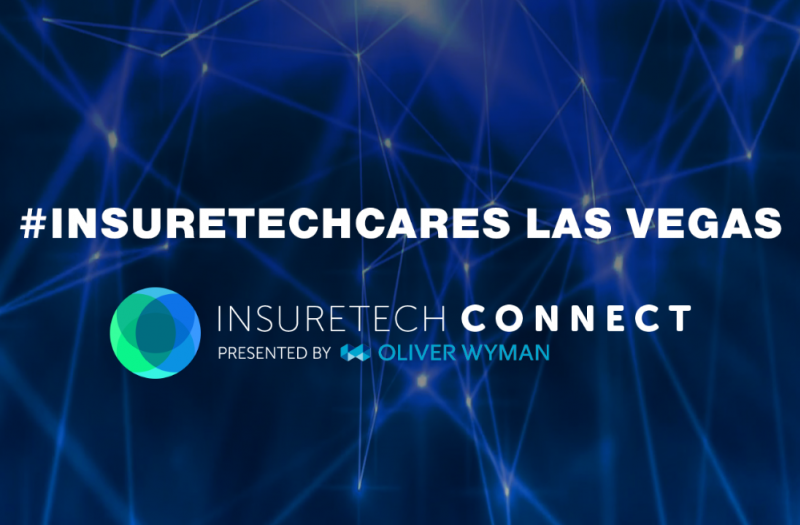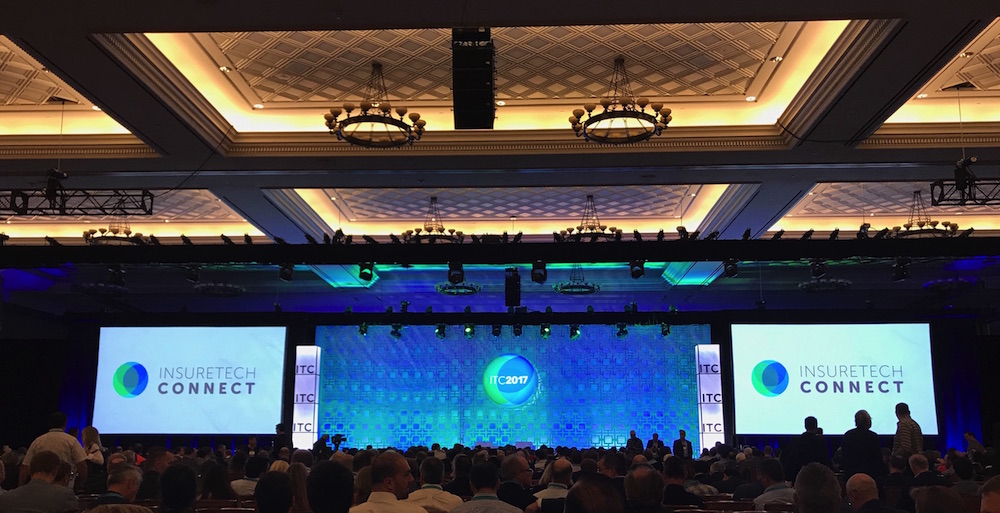
“You should not assume that the world of the future will be anything like the world we live in today.” – James Crawford, CEO, Orbital Insights
Last week Cake & Arrow joined more than 3,500 innovators, investors, and insurance incumbents in Las Vegas for InsureTech Connect 2017. We were thrilled to spend two days among the most innovative minds in the industry and were excited to hear industry leaders speaking fluently the language of customer experience.
While the event took on a somber tone following the horrific scene which took place just up the strip the night before its opening reception, attendees were energized around and inspired by many of the more human-centric themes which emerged throughout the conference– ranging from how insurers can improve people’s lives and more humanely respond in times of crisis to how the industry can proactively reduce the kinds of risks and catastrophic events individuals and companies face in today’s ever evolving world.
Throughout the two days of presentations, debates, and thoughtful dialogues between incumbent carriers, insurtech startups, and VCs, insights were gleaned and themes emerged. Here are our most essential takeaways:
1. The insurance company of the future is customer centric
“I can’t imagine a world where we’d let someone get between us and the customer.” – Steven Mendel, CEO, Bought by Many
This phrase might as well have been the title of the conference, as it was an idea that permeated nearly every conversation that took place over the two day event, on and off the stage. In Tuesday’s panel entitled The Insurance Company of the Future, the moderator ended the session by asking each of the panelists if they were to describe the insurance company of the future in one word, what word would it be. While no panelist was able to do so in one word only, two came close by describing it as customer centric. While this set of panelists had differing viewpoints on how to accomplish customer centricity, they shared the opinion of nearly every other conference speaker and attendee: that to be relevant in the future, insurance must begin and end with the customer. In Tuesday’s View from the C-Suite panel, Paula Downey, President & CEO of the CSAA, offered a compelling bottom-up suggestion on how to instill customer centricity throughout your organization by teaching the Design Thinking process to your employees.
2. Insurance companies need to solve problems, not sell products
“Do something that makes people’s lives better.” – Jamie Siminoff, CEO, Ring
Customer centricity starts with putting people before products (and even before profits), or so believes Ring CEO Jamie Siminoff. In one of the more inspiring conversations that took place on stage at InsureTech Connect, he told American Family’s Telisa Yancy that before his company even begins thinking about money, they are first and foremost focused on reducing neighborhood crime.
It’s no secret that Millennials don’t care much for insurance companies. In fact, recent Bain & Company research found that 80% of Millennials say they would move their insurance business to new entrants that are capable of creating and delivering more value than incumbent insurers, leaving incumbents especially vulnerable to insurtech startups. But when it comes to Millennials, what exactly is value, and how do insurance companies make good on it?
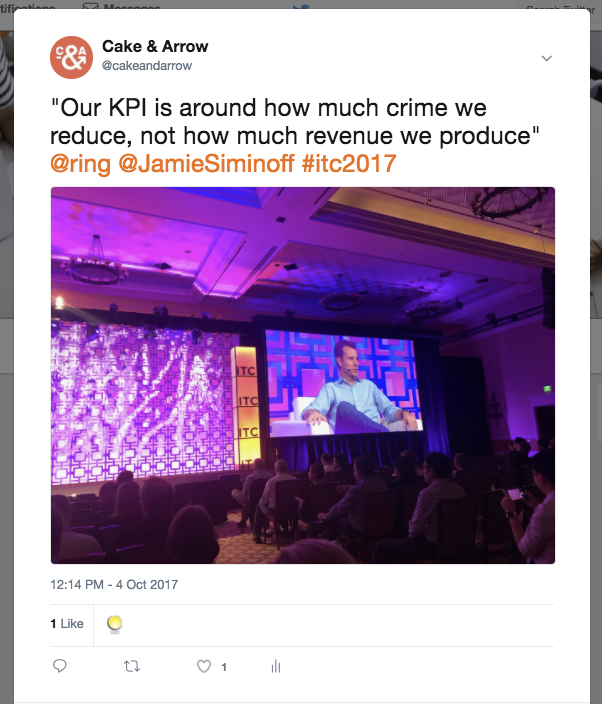
Traditionally, the industry has not been good at this kind of thinking. As Mike McGavick, CEO of XL Catlin pointed out in his talk, the insurance industry is “great at things and poor at ideas.” Rather than solving problems that will “improve people’s lives” (as Ring tries to do), the industry focuses too heavily on selling its existing (and increasingly irrelevant) products, and mistakes going digital for digitizing business as usual, ultimately building products that don’t solve problems.
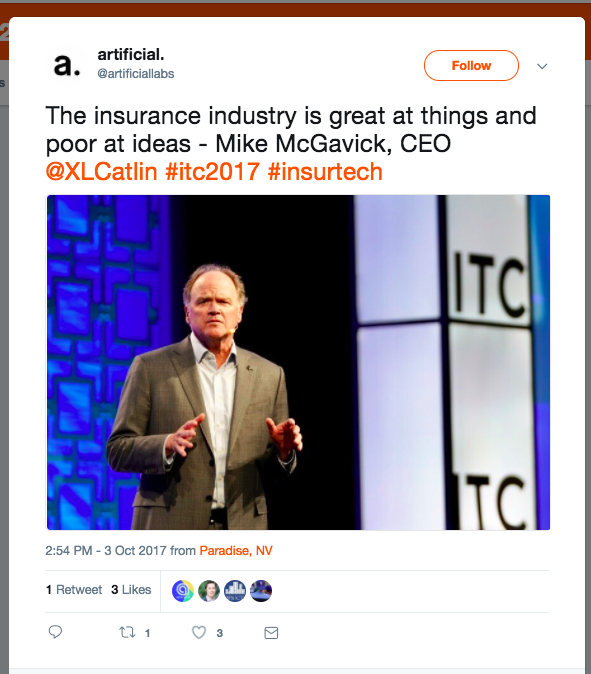
3. Customers can benefit at the same time as insurance companies benefit
“How do you interact with me as a consumer in a natural way that benefits everyone?” – Jamie Siminoff, CEO, Ring
The proof is in the pudding. Ring, which measures its success by crime reduced, not revenue earned, is now valued at over $1billion and has burglary reductions of 50% in neighborhoods where they are utilized. As AI-enabled-two-way conversation takes foot in the industry, allowing insurance companies to enter their customers’ private lives, gaining unprecedented access into their behaviors and mindsets, enabling real-time risk assessment, and engendering trust between traditionally fraught customer and carrier relationships, companies must now determine how to use the technology to ensure a mutually beneficial relationship between themselves and their customers. Continued access to customer data depends on it.
Christina Cragholm, for example, explained how at Nest, a home automation company, they see themselves as guests in people’s homes, and do everything they can to deliver extra value to the customer through ongoing touch points (like the monthly house report they send out) and to be gracious and respectful of the private data their customers are giving them. “It is a core tenant of our company to be totally transparent about what we are doing with your data,” she explained. Being open about what data is being collected and demonstrating how it is beneficial to customers is synonymous with your own success as a carrier. The most successful insurance companies will be those whose customers perceive them not as a necessary expense or cost of doing business, but as an active presence that improves their quality of life.
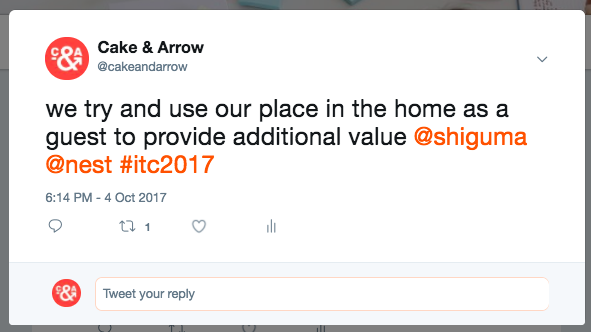
4. It’s time insurance companies move from a passive relationship with customers to an active one
“Handing over control is a big deal – it requires trust and very different skills.” – Prashanth Gangu, Partner, Oliver Wyman
For the past century (and beyond), the relationship between carriers and customers has been mostly transactional, arms length, and generally passive. A customer buys insurance, and then makes contact when there is a claim and possibly when it is time to renew. There is very little contact that happens in between, and the contact that does happen is seldom initiated by the carrier. It is clear that we are moving into a new era in which insurers will play an active role in their customers’ lives, providing additional value along their journey as a customer, and actively helping them reduce risk.
New technologies are enabling insurance carriers to do this in increasingly innovative ways. Companies like Nest and Ring, for example, are using the data from the devices placed in people’s homes to do things like trigger alarms, turn on lights and sprinklers, and are able to communicate regularly with their customers about the safety of their own homes. These are the kinds of active relationships that will deliver more value to customers, but will also engender a more personal relationship between customer and carrier.
5. As the nature of risk changes, so must the insurance products
“A tectonic shift is taking place. – use it to catalyze change within the organization.” – Paula Downey, President & CEO, CSAA
For all insurers, but especially those companies operating in the personal auto space, the imminent future of self driving cars serves as a case study example of how the very nature of risk is shifting–and how companies must adapt and prepare. AI and IoT are now commonplace in our cars, our homes, and our devices, and will soon (if they don’t already) operate everything from our vehicles to our home security systems. As agency shifts from humans to machines, so does liability, and risk.
When your self-driving car of the future gets into an accident, who is responsible? You, the manufacturer that built the car, or the AI making its decisions? These are the kinds of questions insurance companies must anticipate, and in ten years time, know how to answer.
The issue is of the utmost for Paula Downey, President and CEO CSAA. Over the next few decades, as self-driving cars are introduced into the market and driving becomes safer, CSAA expects that premiums will decrease by %40-60, amounting to a billion dollars of lost revenues. What will replace it? We still don’t know.
Such “tectonic shifts,” as Downey describes them, can be used to catalyze change within an organization. Much of this change is at the level of culture. In addition to setting ambitious innovation goals, Downey sees responding to the changing nature of risk, especially as it pertains to the auto industry, as the responsibility of everyone in the organization. She advocates a bottom up and top down approach, explaining that “we want all of our employees to feel that innovation is everybody’s responsibility in the organization.”
6. Innovation doesn’t happen in a vacuum. It happens in a regulatory environment
“We’ve gone from the question of who watches the watchmen, to who watches the robot.” – David Luce, Partner, DLA Piper
While admittedly not the most glamorous topic covered at the conference, the relationship between innovation and regulation was top of mind for both insurtech startups and carriers alike. Many a budding insurtech startup has lost steam and eventually failed due to regulatory problems, while many an incumbent has struggled to innovate, encumbered by rules, regulations, bureaucracy and business as usual. The space in between is where incumbents and innovators can to work together.
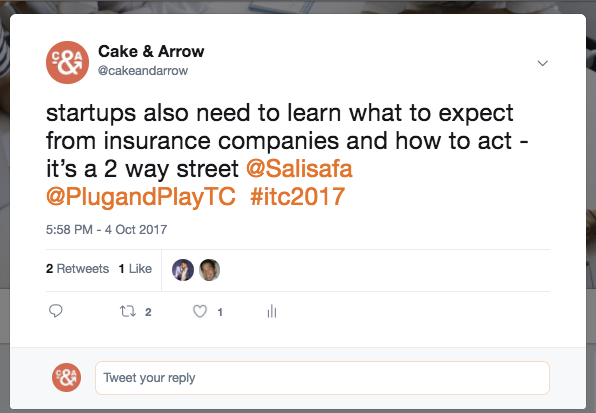
According to Jill Beggs, head of new strategic markets at Munich RE, “carriers have a responsibility to build bridges between regulators and innovators.”
We heard time and time again from successful startups and innovators at the conference that getting to know regulators and tapping the expertise of insurance veterans were both crucial to their success. Chris Cheatham, CEO of Risk Genius urged startups to reach out to regulators early to start talking about how to work together.
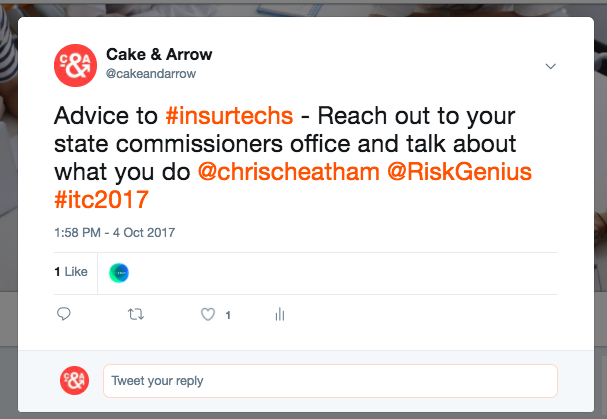
And many regulators are up to the challenge, and eager to partner with innovators. “Regulators have to take a very hard look at how we approach regulation in a way that recognizes change,” said Michael F Consedine, the NAIC’s Chief Executive Officer “We have to adapt as regulators, keep a fair and competitive playing field focused on consumer protection.”
7. Inclusion is more important than diversity
“You’ve attracted the talent, so what’s the experience like?” – Sastry Durvasula, Chief Digital Officer, Marsh
It seemed to be the consensus among industry leaders that to become a truly future-oriented, customer-centric organization calls for a diversity of talent within the organization. A diversity of thought, experience, and perspective helps organizations be more innovative. But the words diversity and inclusion are often used almost interchangeably, as if they are one in the same. They are not. To recruit diverse talent is one thing, but to maintain diverse talent requires companies to adapt in such a way that they are inclusive of diversity. In an industry which remains predominantly white and predominantly male and entrenched in old, often bureaucratic ways of doing business, both can prove difficult.
Diversity can take many forms–gender, race, experience, age, personal and professional background–and inclusive companies must strive to encompass them all. Paula Downey of CSAA challenges insurance industry leaders to lead the charge. “Do we have inclusive leaders?” she asks.
These questions go deeper than HR.
How are companies changing their operating models to be more inclusive? While many of the speakers we heard from were vague on the practices they have actually put in place to increase inclusivity, we heard from several speakers about the need to provide occasions where hierarchies are collapsed–as Sastry Durvasula, Chief Digital Officer at Marsh, put it, to “create a horizontal fabric within the company where people can work together.” For Durvasula, this doesn’t mean doing away with hierarchy or functional roles, it means providing opportunities for people to work together, on a level playing field, outside of these roles.
We heard this a lot. Andrew Breen, SVP of digital at the Argo Group discussed how he tries to pair builders and operators to work together on the same goals, while Durvasula talked about improving what he called employee’s “personal agility,” encouraging everyone – including senior management to be an individual contributor and a “doer.”
And while these kinds of practices certainly engender a specific type of diversity, and definitely help transform the organizational culture, we’re eager to hear more about how companies are answering questions like Downey’s: “Can the experiences of women within your organization become normalized?”
__
The leaps and bounds the insurance industry has taken over the last 12 months toward becoming more customer centric are impressive to say the least. And while the industry definitely knows the language of customer centricity, we are excited to see how they will put it into action over the next year. Stay tuned for InsureTech Connect 2018.
If you’d like to support the victims and the family members affected by the horrific shooting that took place at the Route 91 Harvest country music festival, in which 58 people died and more than 500 were injured, the conference organizers have started a GoFundMe campaign. You can donate here, if you feel so moved. #VegasStrong #InsureTechCares
